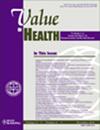The Increasing Use of Clinical Outcome Assessments in US Food and Drug Administration Labels and the German Gemeinsamer Bundesausschuss, National Institute for Health and Care Excellence, and the French Haute Autorité de Santé Assessments From 2012 to 2022
IF 6
2区 医学
Q1 ECONOMICS
引用次数: 0
Abstract
Objectives
Clinical outcome assessments (COAs) are increasingly used in clinical trials. However, knowledge gaps remain around their inclusion in market access decision making for pharmaceuticals and the perceived added value in capturing the patient experience. This study examined trends in the inclusion of COAs in US Food and Drug Administration (FDA) labels and European health technology assessments (HTAs) beyond those that are essential for assessing primary endpoints or determining cost-effectiveness.
Methods
The inclusion of nonmandatory COAs was analyzed in FDA labels and HTAs of German, French, and English bodies, from 2012 to 2022. Changes in COA use are reported overall, by COA type, concept, and therapeutic area.
Results
In FDA labels, the inclusion of nonmandatory COA increased from 18.6% to 28.4% from 2012-2016 to 2017-2022. The average number of unique COAs in FDA labels approximately doubled. Nonmandatory COA inclusions in HTAs increased from 45.2% to 64.9%. The average number of unique COAs per HTA also approximately doubled. Patient-reported outcomes were the most reported COAs in FDA labels and HTAs in both time periods. In FDA labels and HTAs, most therapeutic areas showed increases in nonmandatory COA inclusion. In FDA labels, COA instruments mostly measured signs and symptoms. In HTAs, they mostly measured health status and quality of life.
Conclusions
The findings show increasing trends in the use of nonmandatory COA in HTAs and, to a lesser extent, FDA labels, suggesting a greater awareness of COA benefits and a changing practice of inclusion toward more patient centricity.
从2012年到2022年,在FDA标签和G-BA、NICE和HAS评估中越来越多地使用临床结果评估。
目的:临床结果评估(COAs)在临床试验中的应用越来越广泛。然而,在将其纳入药品市场准入决策以及在获取患者体验方面的感知附加值方面,知识差距仍然存在。本研究调查了在美国食品和药物管理局(FDA)标签和欧洲卫生技术评估(hta)中纳入coa的趋势,超出了评估主要终点或确定成本效益所必需的范围。方法:分析德国、法国和英国机构2012-2022年FDA标签和hta中“非强制性COAs”的包含情况。根据COA类型、概念和治疗领域(TA),报告了COA使用的总体变化。结果:从2012-2016年到2017-2022年,FDA标签中非强制性COA的比例从18.6%增加到28.4%。FDA标签中唯一coa的平均数量大约翻了一番。hta中非强制性COA含量从45.2%增加到64.9%。每个HTA的唯一coa的平均数量也大约翻了一番。患者报告的结果(PROs)是两个时间段内FDA标签和hta中报告的coa最多的。在FDA标签和hta中,大多数ta显示非强制性COA包含增加。在FDA标签中,COA仪器主要测量体征和症状。在hta中,他们主要测量健康状况和生活质量。结论:研究结果显示,在hta中使用非强制性COA的趋势越来越多,FDA标签的使用程度也越来越低,这表明人们对COA的益处有了更大的认识,并且越来越多地以患者为中心。
本文章由计算机程序翻译,如有差异,请以英文原文为准。
求助全文
约1分钟内获得全文
求助全文
来源期刊

Value in Health
医学-卫生保健
CiteScore
6.90
自引率
6.70%
发文量
3064
审稿时长
3-8 weeks
期刊介绍:
Value in Health contains original research articles for pharmacoeconomics, health economics, and outcomes research (clinical, economic, and patient-reported outcomes/preference-based research), as well as conceptual and health policy articles that provide valuable information for health care decision-makers as well as the research community. As the official journal of ISPOR, Value in Health provides a forum for researchers, as well as health care decision-makers to translate outcomes research into health care decisions.
 求助内容:
求助内容: 应助结果提醒方式:
应助结果提醒方式:


